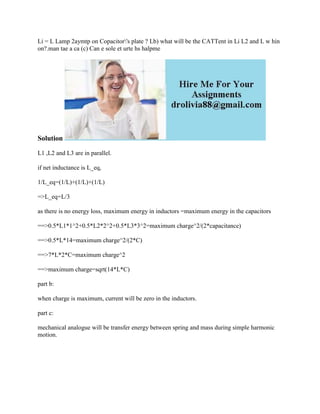Li - L Lamp 2aymtp on Copacitor-'s plate - Lb) what will be the CATTen.docx
•Descargar como DOCX, PDF•
0 recomendaciones•4 vistas
Li = L Lamp 2aymtp on Copacitor\'s plate ? Lb) what will be the CATTent in Li L2 and L w hin on?.man tae a ca (c) Can e sole et urte hs halpme Solution L1 ,L2 and L3 are in parallel. if net inductance is L_eq, 1/L_eq=(1/L)+(1/L)+(1/L) =>L_eq=L/3 as there is no energy loss, maximum energy in inductors =maximum energy in the capacitors ==>0.5*L1*1^2+0.5*L2*2^2+0.5*L3*3^2=maximum charge^2/(2*capacitance) ==>0.5*L*14=maximum charge^2/(2*C) ==>7*L*2*C=maximum charge^2 ==>maximum charge=sqrt(14*L*C) part b: when charge is maximum, current will be zero in the inductors. part c: mechanical analogue will be transfer energy between spring and mass during simple harmonic motion. .
Denunciar
Compartir
Denunciar
Compartir

Recomendados
Recomendados
Más contenido relacionado
Más de sthomas232
Más de sthomas232 (20)
Let F -- L be a finite extension of fields- and let L - F-a- for some.docx

Let F -- L be a finite extension of fields- and let L - F-a- for some.docx
Many intuitively plausible beliefs conflict with science- For example-.docx

Many intuitively plausible beliefs conflict with science- For example-.docx
maom an learning What is the concentration of an HBr solution if 28-5.docx

maom an learning What is the concentration of an HBr solution if 28-5.docx
Let be unknown constants and consider the linear system- This syst.docx

Let be unknown constants and consider the linear system- This syst.docx
Many companies such as McDonalds have embraced supply chain management.docx

Many companies such as McDonalds have embraced supply chain management.docx
made a year end adjusting entry to accrue interest on a note payable t.docx

made a year end adjusting entry to accrue interest on a note payable t.docx
List some advantages of having a well developed international code of.docx

List some advantages of having a well developed international code of.docx
List several of the major differences between manufacturing and servic.docx

List several of the major differences between manufacturing and servic.docx
Mack and Joan are married but Mack moved out of the family home in Oct.docx

Mack and Joan are married but Mack moved out of the family home in Oct.docx
luonbcator assignment-take uonor ior SPeCIes war acuAS OUTIOS ouy acce.docx

luonbcator assignment-take uonor ior SPeCIes war acuAS OUTIOS ouy acce.docx
Luther recently received $30-000 of compensation for some consulting w.docx

Luther recently received $30-000 of compensation for some consulting w.docx
Let A be an invertible matrix such that - where L and L1 are unit low.docx

Let A be an invertible matrix such that - where L and L1 are unit low.docx
LS P Explain how one can be certain whether an unknown contains the I.docx

LS P Explain how one can be certain whether an unknown contains the I.docx
Let A and B be rings- and f - A -- B a homomophism-Prove that f is inj.docx

Let A and B be rings- and f - A -- B a homomophism-Prove that f is inj.docx
Lollipop Inc- completed transactions during 2013- journal transactions.docx

Lollipop Inc- completed transactions during 2013- journal transactions.docx
List three qualities of software that make it vulnerableSolutionThe th.docx

List three qualities of software that make it vulnerableSolutionThe th.docx
List the main documents that are created during the architecture and u.docx

List the main documents that are created during the architecture and u.docx
List the circumstances under which land would be classified under the.docx

List the circumstances under which land would be classified under the.docx
List the matters an auditor should consider when developing an audit p.docx

List the matters an auditor should consider when developing an audit p.docx
List and define the factors that are important to successful implement.docx

List and define the factors that are important to successful implement.docx
Último
APM Welcome, APM North West Network Conference, Synergies Across Sectors

APM Welcome, APM North West Network Conference, Synergies Across SectorsAssociation for Project Management
Mehran University Newsletter Vol-X, Issue-I, 2024

Mehran University Newsletter Vol-X, Issue-I, 2024Mehran University of Engineering & Technology, Jamshoro
Último (20)
SECOND SEMESTER TOPIC COVERAGE SY 2023-2024 Trends, Networks, and Critical Th...

SECOND SEMESTER TOPIC COVERAGE SY 2023-2024 Trends, Networks, and Critical Th...
Beyond the EU: DORA and NIS 2 Directive's Global Impact

Beyond the EU: DORA and NIS 2 Directive's Global Impact
Presentation by Andreas Schleicher Tackling the School Absenteeism Crisis 30 ...

Presentation by Andreas Schleicher Tackling the School Absenteeism Crisis 30 ...
This PowerPoint helps students to consider the concept of infinity.

This PowerPoint helps students to consider the concept of infinity.
APM Welcome, APM North West Network Conference, Synergies Across Sectors

APM Welcome, APM North West Network Conference, Synergies Across Sectors
Web & Social Media Analytics Previous Year Question Paper.pdf

Web & Social Media Analytics Previous Year Question Paper.pdf
Russian Escort Service in Delhi 11k Hotel Foreigner Russian Call Girls in Delhi

Russian Escort Service in Delhi 11k Hotel Foreigner Russian Call Girls in Delhi
Li - L Lamp 2aymtp on Copacitor-'s plate - Lb) what will be the CATTen.docx
- 1. Li = L Lamp 2aymtp on Copacitor's plate ? Lb) what will be the CATTent in Li L2 and L w hin on?.man tae a ca (c) Can e sole et urte hs halpme Solution L1 ,L2 and L3 are in parallel. if net inductance is L_eq, 1/L_eq=(1/L)+(1/L)+(1/L) =>L_eq=L/3 as there is no energy loss, maximum energy in inductors =maximum energy in the capacitors ==>0.5*L1*1^2+0.5*L2*2^2+0.5*L3*3^2=maximum charge^2/(2*capacitance) ==>0.5*L*14=maximum charge^2/(2*C) ==>7*L*2*C=maximum charge^2 ==>maximum charge=sqrt(14*L*C) part b: when charge is maximum, current will be zero in the inductors. part c: mechanical analogue will be transfer energy between spring and mass during simple harmonic motion.